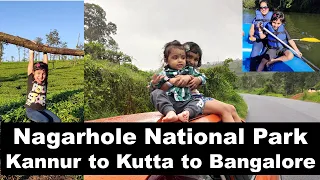Iruppu Waterfalls & Water Rafting at Barapole River | Learn With Pari
After the sun-soaked beaches and historic forts of Bekal and Muzhappilangad, it was time to leave the coastline and head toward the lush forests and thrilling rivers of the Western Ghats. In this Part 2 of our Kerala trip, we took a scenic drive from Kannur to the Nagarhole National Park region, exploring Iruppu Waterfalls and the exciting Barapole River on the way.
And yes, Pari was more excited than ever—because this leg of the trip was all about adventure, nature, and wildlife!
📍 Route Overview
- Start Point: Kannur, Kerala
- End Point: Nagarhole National Park (near Kutta, Karnataka)
- Major Stops: Iruppu Waterfalls, Barapole River (for rafting)
- Distance: Approx. 150–170 km
- Travel Time: 5–6 hours by car
- Best Season: Monsoon to early winter (July to January) – waterfalls and rivers are full!
🌳 Into the Wild – Nagarhole National Park
As we drove inland, the landscape changed from palm-lined beaches to dense forests and rolling hills. Nagarhole, also known as Rajiv Gandhi National Park, is one of India’s best tiger reserves—but it’s also home to elephants, deer, leopards, wild dogs, and hundreds of bird species.
🚙 Safari Experience
We booked a jeep safari early in the morning at the Nagarhole Gate (Kutta side). The excitement of seeing animals in their natural habitat made this a truly unforgettable day.
What We Saw:
- A herd of elephants crossing the road
- Spotted deer, langurs, and giant squirrels
- Peacocks dancing in the early morning light
- Lots of birdlife—Pari even spotted a hornbill!
Tip for Families:
- Book your safari in advance.
- Wear neutral-colored clothes.
- Keep quiet and respect the wildlife.
💦 Iruppu Waterfalls – Nature’s Playground
Before reaching Nagarhole, we made a refreshing stop at the Iruppu Waterfalls, located in the Brahmagiri Range, just about 20 km from Kutta.
🏞️ What to Expect
- A short trek (about 1 km) through a beautiful forest trail
- The sound of gushing water growing louder as you walk
- A stunning 170-foot waterfall tumbling down the rocks
Why Kids Love It:
Pari loved the trek and splashing her feet in the cool water near the base (safely, of course!).
Why Parents Love It:
Clean surroundings, scenic views, and a peaceful atmosphere. A great way to introduce kids to nature!
Travel Tip:
Wear comfortable shoes and carry an extra set of clothes if you’re planning to get wet.
🌊 Barapole River – Adventure Time!
Just a short drive from Iruppu lies one of the best-kept secrets for adventure lovers in South India—the Barapole River, known for white water rafting.
🚣♂️ River Rafting Highlights
- Rapids ranging from Grade 2 to Grade 4 – perfect for beginners and thrill-seekers
- Professional guides ensure safety
- Gorgeous forest scenery along the riverbanks
Is it safe for kids?
Rafting is allowed for ages 14 and above, so Pari had to sit this one out—but she enjoyed watching from the riverside while cheering us on!
Family Tip:
If your kids are too young for rafting, explore nearby nature trails or go for a short forest walk instead.
🏨 Where to Stay
There are several eco-resorts and homestays near Kutta (on the Karnataka side), close to both Nagarhole and Iruppu.
Family-friendly options include:
- Jungle Inn Resort, Kutta
- Red Earth Kabini (a bit farther, for luxury seekers)
- Local homestays with home-cooked food and warm hospitality
🧳 Travel Tips for Families
- Start early from Kannur to make the most of your day.
- Keep snacks, water, binoculars, and a basic first aid kit in your car.
- Respect nature—don’t litter and avoid loud music in forest areas.
- If traveling during monsoon, carry raincoats or umbrellas.
📚 What Pari Learned on This Trip
- The importance of wildlife conservation
- How to recognize animal footprints during the safari
- The science behind waterfalls and river rapids
- Why forests are called the “lungs of the Earth”




